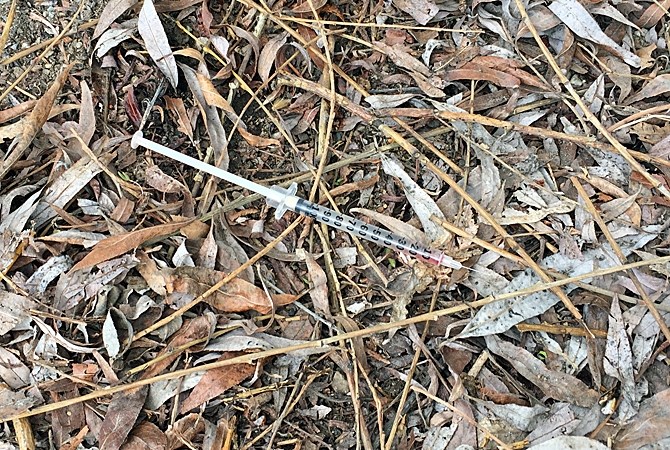
Overdose deaths are up 30 per cent in Kelowna.
Image Credit: Shutterstock
February 27, 2016 - 12:00 PM
OVERDOSES UP AS FENTANYL LOOMS; IS IT TIME FOR A SAFE INJECTION SITE IN THE INTERIOR?
THOMPSON-OKANAGAN - As drug overdoses and deaths spike in the B.C. Interior and the scourge of fentanyl-tainted drugs shows no signs of abating, health officials are preparing a response and everything is being considered.
But are cities like Kelowna and Kamloops ready for a safe injection site?
If you ask Dr. Trevor Corneil, senior medical health officer for the Interior Heatlh Authority and an expert in harm reduction, the answer is straightforward.
“Absolutely, without question," he says. "Not only would the Ministry of Health be supportive, but Interior Health would directly support a safe injection site or an agency that was willing to do so.”
If he was making that call it might be that simple but Corneil knows it's not.
“Now saying that is quite a bit easier than actually getting it done. It requires a significant amount of policy and procedural work and also proper engagement with the community,” Corneil adds.
He also points out the political winds have shifted with the federal Liberal government showing a new willingness to consider safe injection services beyond Vancouver, once ideological toxin to their Conservative predecessors.
“The attitude toward safe injection and harm reduction has definitely changed,” Corneil says. “It's not just big cities that could benefit. It’s a question that deserves to be asked."
GROWING PAINS
Kelowna might be the best starting point for the B.C. Interior. While it reaps the rewards of its torid pace of growth, City bylaw reports a doubling of calls to so-called tramp camps; that’s anything from a piece of cardboard behind a dumpster downtown to a full-on campsite in the woods.
Bylaw officers are also reporting more drug detritus left behind, used needles mostly, and Kelowna’s social service agencies, too, say they are seeing a different kind of drug use amongst clients, more injection drugs and more opioids.
“Particularly this year, we’ve noticed a huge increase in IV drug use in the community,” Inn from the Cold executive director Jan Shulz says. “We have our regulars that have been accessing services for a number of years but there’s a new element to the clients this season, who are more obviously involved with the drug scene.”
Inn from the Cold is a shelter of last resort for the homeless during winter. Shulz says staff are trained to administer naloxone, a drug used to reverse opioid overdoses and were forced to use it for the first time during an early winter cold snap and several times since.
“It’s certainly not just us that’s noticing it. Other agencies are seeing this too,” Shulz adds.
Kelowna Gospel Mission director Randy Benson confirms they’ve recently lost long-term clients to overdoses at the mens shelter.
“It was quite upsetting. Some of the people that had been using our services, suddenly they were gone," he says.
Hard numbers on drug overdoses are hard to come by (unless they die). The Interior Health Authority does not track overdoses in real time, instead relying on database of information from front line emergency room staff plus police and ambulance reports.
Dr. Corneil says it’s quite normal for Kelowna General Hospital, the Interior Health Authority’s largest, to see one to five overdoses per week, from a variety of substances including alcohol.
“Five certainly wouldn’t be unusual,” he adds.
Most are not fatal, but some are. The B.C. Coroners Service reported in January that Kelowna had experienced a 30 per cent spike in overdose deaths in 2015, to 17 from 12.
Province-wide, the coroner’s service reports a 27 per cent increase in overdose deaths to 465 in in 2015 with fentanyl reported alone or in combination with other drugs in 30 per cent of cases.
Coroner Barb McClintock could not comment on the individual circumstances or whether a safe injection site could have made a difference in any of the Kelowna deaths.
“Overall, as a form of harm reduction, safe injection sites do reduce the number of overdose deaths,” McClintock says.

Street drug use drops in the area around a safe injection site.
Image Credit: Julie Cancela
REDUCING HARM
There are multiple forms of harm reduction for all kinds of addictions and their benefits are many and varied and largely available.
For injection drug users, a ready supply of clean needles reduces sharing, which helps cut transmission rates of disease including HIV and hepatitis C. Safe injection kits with alcohol, clean water and sterile swabs further reduce the spread of disease and the problems associated with introducing a drug directly into your bloodstream.
Naloxone is the Hail Mary of the opioid world, in some ways a true miracle drug that can reverse the effects of narcotics long enough for paramedics to arrive.
But naloxone isn’t perfect. It doesn’t work on cocaine or crystal meth or other drugs and still requires someone else to recognize the signs of overdose and administer the drug. That’s a dodgy prospect. if there is someone around, they may also be high and fearful of prosecution should the authorities get involved.
Supervised safe injection is the missing piece, filling the gap in the harm reduction continuum between handing out clean needles and naloxone and winding up in the emergency room or in a body bag.
But it is also a deal breaker for many people who can't get past the idea of someone purposely exposing themselves to harm to get high or even worse, providing a service that allows them to do drugs at taxpayer’s expense.
“Unfortunately for a lot of people it is still a black-and-white issue,“ Anna Marie D'Angelo says. As media relations officer for Insite, Vancouver’s supervised injection site, she has heard it all before.
“Science has proven harm reduction does work, it’s as simple as that and it doesn’t cause anyone to use more or less.”
Insite’s inception in 2003 as North America’s first supervised injection site was driven by the reality of the drug scene in Vancouver’s Downtown Eastside, D’Angelo says.
“We had the highest HIV transmission rate in the industrial world. And people were dropping like flies, overdosing and dying in record numbers."
Since then, Insite has proven to be a small oasis in the Downtown Eastside, recording several thousand overdoses but losing none under the supervision of registered nurses. Thousands more have made it to Onsite, the lesser-known detox facility and recovery house that operates upstairs, something D’Angelo laments.
“Insite gets all the media attention but it’s just part of the continuum of care."
SAFE INJECTION UP CLOSE
Long-time cocaine addict Randy, now in recovery, describes Insite as having a “weird, energy around it. You're getting high with all these strangers around you, but it definitely feels safe.”
A construction worker who operates specialized machinery, Randy wasn’t homeless and didn’t live in the Downtown Eastside but would wind up there every time he broke down and went on a coke binge.
He gives Insite and its full spectrum service — addictions counsellors are always on duty — the credit for keeping recovery front and centre even as its nurses supervised him while injecting cocaine.
“They don’t shove recovery down your throat but it’s always there. I know having it there always made me think about it a lot more."
Randy firmly believes most serious addicts have, like him, some kind of underlying mental illness or past childhood trauma driving their behaviour and that nothing the police or courts can do will stop their need to self-medicate.
“They obviously can’t stop it so they might as well deal with it.”
A statistical snapshot of Insite shows over 9,000 individuals visiting Insite’s Hastings Street location in 2012 (around the last time Randy used the service) averaging just over 1,000 visits a day with another 500 visits to the injection room.
The organization is entirely funded and run by the Vancouver Coastal Health Authority. Almost a quarter of the clients were women and 17 per cent were aboriginal. The drug of choice was most often heroin (51 per cent) followed by cocaine (22 per cent) and crystal meth (10 per cent).
To D’Angelo, safe injection distills down to dollars and common sense if compassion isn’t enough.
“We can help keep them alive and reduce the spread of disease. It costs a fortune to treat people with these diseases. And Insite is a good place to connect people with heath care workers and maybe get them to take that first step to improve their lives.”
As for getting it done in Kelowna or anywhere else, Dr. Corneil says people should consider the Vancouver experience before making up their minds. Local business leaders and police were initially skeptical but brought onside once they saw the results.
Corneil is by no means suggesting the Vancouver solution for Kelowna or Kamloops' problem but nor is he suggesting it requires widespread community support — any sort of public referendum on the subject would be a disaster, he says.
“This is for the stakeholders, the related businesses in the area, community members who feel impacted by this kind of drug use,” Corneil adds. “We should be actively pursuing evidence based approaches to harm reduction."
TOMORROW: SAFE INJECTION MAKES LOCAL LEADERS DANCE
To contact the reporter for this story, email John McDonald at jmcdonald@infonews.ca or call 250-808-0143. To contact the editor, email mjones@infonews.ca or call 250-718-2724.
News from © iNFOnews, 2016